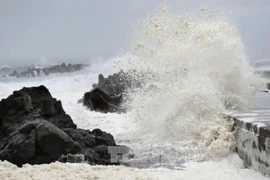 Ea Juo Reservoir in the Central Highlands province of Dak Lak dries up due to the prolonged heat wave. The photo was taken on March 20 (Photo: VNA)
Ea Juo Reservoir in the Central Highlands province of Dak Lak dries up due to the prolonged heat wave. The photo was taken on March 20 (Photo: VNA)Hanoi (VNA) — Vietnam is forecast to suffer the highest temperatures everrecorded in 2020, according to the latest report by the Vietnam Meteorologicaland Hydrological Administration.
In May, the country will see more days of heat than the samemonth of previous years, said the agency.
The country is predicted to face increasing and complicatedpattern of natural disasters this year due to the impact of global warming andmelting of glaciers, the administration said.
Since the beginning of 2020, abnormal weather events havebeen reported in different areas of the country, including unprecedentedhailstorms in northern provinces in March.
Meanwhile, the central and southern regions are sufferingfrom severe drought and saline intrusion.
Heavy rains are forecast in central and southern provinces atthe end of 2020.
The rainfall in the north-western area in May and October ispredicted to witness a decline of 10 to 25 percent compared to previous years’average. Meanwhile, in the north-eastern area, the rainfall in June andSeptember is expected to rise from 10 to 25 percent compared to previous years’average.
The central region, however, is told to prepare for prolongeddroughts, with rainfall at the beginning of the rainy season lower thanprevious years’ average.
The rainy season is predicted to come late in the CentralHighlands and the south, worsening the shortage of water till early May.
In October, the two regions’ rainfall will be 15 to 30percent higher than the same period last year and the rainy season is forecastto end late.
“There is a slim chance to have an early flood in southerndeltas,” the report read.
The annual flood peak at the headwaters of the Cuu Long(Mekong) River on Tien River in Tay Ninh province’s Tan Chau town and Hau Riverin An Giang province’s Chau Doc district is foreseen to be 0.2 to 0.4 m lowerthan the annual flood peak. The flood peak will appear by the end of September.
According to a report released by World MeteorologicalOrganisation (WMO) in January, 2019 was the second hottest year on recordfollowing 2016.
“The year 2020 has started out where 2019 left off – withhigh-impact weather and climate-related events,” said WMO Secretary-GeneralPetteri Taalas./.





























